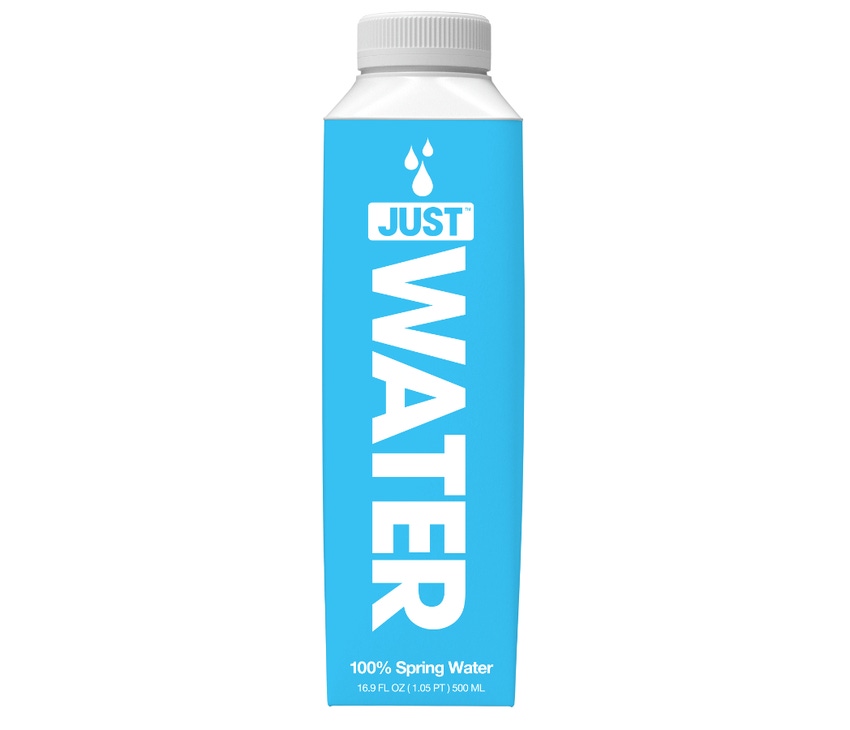
Sustainability, shelf appeal and product protection were key concerns for Just Beverages as it considered packaging options for its new spring water product. A package that combines the best features of paper-based cartons and conventional bottles—the Tetra Top carton bottle from Tetra Pak—addressed all three issues.
Just Water is filled at ambient temperature into 500-ml Tetra Top packaging. The water is sourced from a watershed at the base of the Adirondack Mountains in New York, and the product began a staged, national rollout August 2015.
The single-serve package has a square footprint and round screw cap. The closure and molded neck are high-density polyethylene (HDPE), but the body of the container is formed from a six-layer material incorporating paper, low-density polyethylene (LDPE) and aluminum.
Just Water carton bottles are 53% paper, according to the brand owner. The paper is sourced from managed forests certified by the Forest Stewardship Council and the Rainforest Alliance.
Further, consumers can recycle the packages—if their community offers carton recycling. According to Steve Nichols, vp of sales for Tetra Pak U.S. and Canada, the Tetra Top package does not need to be disassembled prior to recycling in the United States.
Nichols answers additional questions about the Just Water package, noting that it marks the global launch of Tetra Top for spring water and the screw-cap package’s first use in the United States for any product.
What is the Just Water package’s shape?
Nichols: It’s a sleek bottle-shaped design that is easy to carry around and fit into a car cup-holder, making it ideal for consumers’ on-the-go lifestyles. It offers the convenience and functionality of a bottle with the environmental profile of a carton. Its fully printable body offers complete customization, with a wraparound billboard effect that stands out on retail shelves.
How is it printed?
Nichols: It’s printed as part of the converting process that turns raw materials into carton packaging. The design is applied to the paper prior to lamination via Tetra Pak’s Flexo Process flexographic printing method. The result is photographic-quality printing with fresh colors.
How does the package protect the purity (flavor) of the water?
Nichols: As with all Tetra Pak cartons, protecting the flavor and quality of the products inside is a top priority. We ensure our packages contain no unwanted bacteria, chemicals or other unsafe ingredients, so they protect the contents hygienically and preserve their nutritional value and flavor. In addition, Tetra Top’s non-transparent packaging blocks ultraviolet (UV) light from reaching the beverage, which helps to protect its overall quality.
Please describe the converting process used to create the package.
Nichols: First, the design is printed on large rolls of paper that are sourced from responsibly managed forests where harvested trees are replaced with new ones. Next, the printed paper is laminated with very thin layers of LDPE and aluminum to generate a roll of carton packages that protect against light and oxygen. After being palletized, the packaging rolls are ready to be shipped to the manufacturer for filling. Inside the filling equipment, the flat packaging material is formed into the familiar carton-bottle shape, the neck and cap are applied via injection molding and the package is filled with product.
Like all our cartons, Tetra Top was designed to have a reduced environmental impact in the manufacturing process through water and energy conservation.
Tell us a little more about the filling equipment.
Nichols: The Tetra Top filling machine is a form, fill and seal system. After the packaging material is fed into the machine, packages are cut into blanks and formed into sleeves. The HDPE shoulder and cap are then injection-molded to the sleeve. Finally, the formed packages are filled from the bottom, sealed and turned upright before being discharged from the filler.
About the Author(s)
You May Also Like




